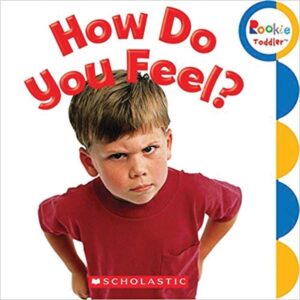Awareness of emotions
Toddlers participate in a book sharing about different types of feelings.



Be Prepared: Limit participation to no more than three toddlers so all children can see pictures in the small board book.
[Invite up to three toddlers to join you in reading a book about feelings.]
We are learning about how we might feel when something happens. Some things make us feel happy. Sometimes things happen that make us feel mad. Sometimes we feel sad.
 [Display book cover.]
[Display book cover.]
Look at the boy on the cover of our book. What do you think this boy is feeling? (mad, angry)
Our book has pictures of children who are feeling different things. Some children are feeling happy. Some children are feeling mad. Let’s look inside our book. Maybe we will see the picture of this boy again.
[Point to book title as you read it.]
Our book is called, How Do You Feel?
[Share two adjacent book pages at a time in the following ways:
The children shown in our book had different kinds of feelings. Is it okay to have different kinds of feelings? Why?
Sharing two adjacent pages at a time provides opportunities for toddlers to look carefully at the book’s colorful, informative pictures and consider how a facial expression represents a feeling. Focused discussion of the feelings covered in this book can help toddlers strengthen their awareness of specific feelings and perhaps broaden their understanding of circumstances associated with a feeling. Stay in tune with toddlers’ reactions to pictures or discussion so you can tailor your approach to each two-page segment in response to toddlers’ interests or concerns.
Extra support
Enrichment
Awareness of emotions
Toddlers participate in a picture-focused discussion of events associated with different feelings and how feelings can change.



Be Prepared: This is a follow-up activity for toddlers who are familiar with the How Do You Feel? book through participation in Option 1 or a similar book sharing.
 Invite 3–4 toddlers to join you in talking about pictures of children who are having different kinds of feelings. Open the session by showing the book cover and reminding toddlers that our book tells about different feelings. Explain that you will read the book again and then we can talk about some of the children shown in the book. Use the following approach:
Invite 3–4 toddlers to join you in talking about pictures of children who are having different kinds of feelings. Open the session by showing the book cover and reminding toddlers that our book tells about different feelings. Explain that you will read the book again and then we can talk about some of the children shown in the book. Use the following approach:
Conclude the session by recalling some of the events or circumstances (discussed in the session) that make us feel happy or sad or mad. Remind toddlers that there are many feelings we feel every day. Our feelings can change.
The small board book featured in this activity contains a lot of helpful information for toddlers, including colorful and realistic pictures of children. Opening the session by reading the book text without elaboration provides a reminder of the book’s content. Reading all text at once is in contrast with the segmented reading of text in Option 1. The suggested strategies for approaching the current session are intended to unpack the book’s information in two areas: events or circumstances associated with a specific feeling and how feelings (and their facial expressions) can change.
Toddlers may find it challenging to generate examples of a good thing that could happen to help the boy who is feeling sad (from a fall) to feel happy again. Offer one or two realistic possibilities that might prompt toddlers to think of others. See the Extra Support tip. Toddlers will likely enjoy making a big smile and then a frown. The experience of transitioning from a frown to a smile is a unique part of this activity.
Extra support
Enrichment
Materials Needed: How Do You Feel? (Rookie Toddler) by Jodie Shepherd, 3–4 nonbreakable handheld mirrors
Use the colorful pictures in this easy-to-handle board book to support toddlers in exploring facial expressions associated with different feelings. Invite toddlers to think about what his/her face might look like when experiencing an emotion featured in the book. Encourage toddlers to look at their facial expression in a handheld mirror and compare it to a facial expression shown in the book for the same emotion. Emphasize that happy faces can look different, sad faces can look different, and mad faces can look different. Example: The mad faces of the boy and girl are different.
Materials Needed: see activity description
Preschool-age children may enjoy participating in Options 1 and 2. Their experiences with feeling embarrassed or excited may be especially helpful to discussions in Option 2. Younger toddlers (12–24 months) may enjoy looking at the pictures of children in the How Do You Feel? board book.